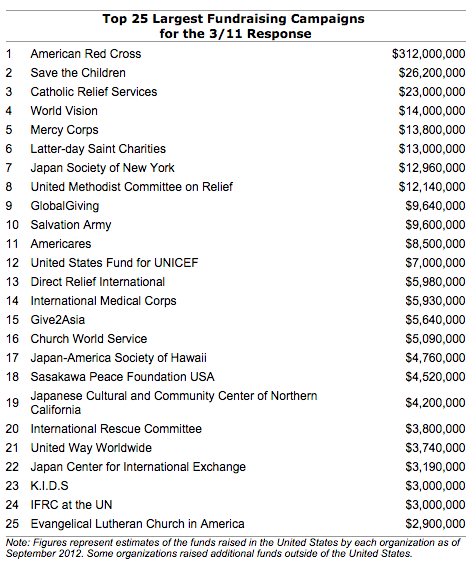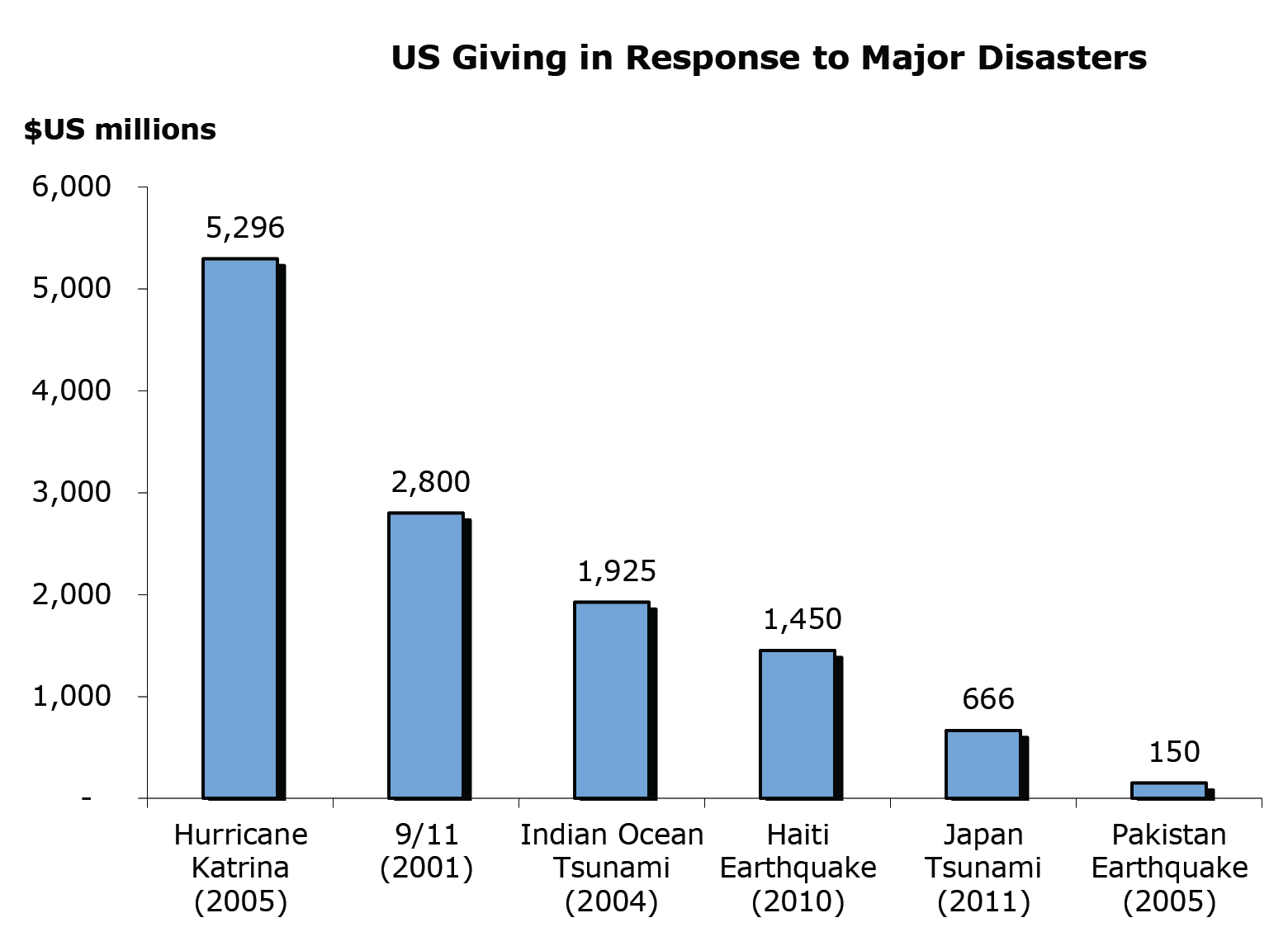September 11, 2012
A JCIE survey of nearly 1,000 nonprofits, businesses, and philanthropic foundations reveals that, in the 1 1/2 years since Japan’s Tohoku region was devastated by a massive earthquake and tsunami, Americans have donated at least $665.8 million (¥53.3 billion) for relief and recovery efforts. This outpouring of charitable giving represents the largest US philanthropic response ever to an overseas disaster in a developed country.
The latest tally represents a revision to an earlier JCIE survey that had recorded $630 million in US giving as of March 1, 2012, and the increase in giving is due to more accurate fundraising reports after the end of the Japanese fiscal year on March 31 and new donations collected in the last six months.
Characteristics of the US Response
 In examining the updated data, several points stand out:
In examining the updated data, several points stand out:
- This ranks as the third most generous American charitable response to an overseas disaster after the 2004 Indian Ocean tsunami and the 2010 Haiti earthquake, both of which struck poorer, developing countries that clearly had great need.
- It is the fifth largest incidence of US giving for any disaster—whether at home or abroad.
- Unlike many other disasters, most of the giving for Japan was in cash rather than in-kind goods and services. Monetary donations account for more than 98 percent of all contributions. This is due to the fact that, as a highly developed nation, Japan already had sufficient supplies and goods available elsewhere domestically and donors quickly recognized that sending unwanted materials would be a hindrance rather than a help.
- Most of the funds raised for the disaster were eventually sent to Japan through large-scale humanitarian relief organizations—groups like the Red Cross, Save the Children, and World Vision—but the diversity of organizations acting as intermediaries to channel funds to recipients on the ground has been extraordinary. More than 330 American organizations, primarily nonprofits, have given directly to Japanese groups, with 41 organizations raising more than $1 million each and 16 surpassing $5 million.
Key Role of Grassroots Ties
One way in which the response of the American public to the 3/11 disaster has stood out is its nature as a grassroots phenomenon. High profile national appeals were launched in response to the 2004 Indian Ocean tsunami and the 2010 Haiti Earthquake, with former Presidents Bill Clinton and George H.W. Bush teaming up to encourage Americans to donate after the 2004 tsunami and President Clinton and George W. Bush mobilizing US giving for the Haiti earthquake in response to a request from President Obama. In comparison, while the US military quickly provided humanitarian assistance to Japan, there was no coordinated national effort to mobilize American philanthropy. In fact, while some US organizations launched appeals, many groups decided not to aggressively raise funds since Japan is a rich country and they did not feel they had sufficient expertise to operate there.
Instead, in the case of Japan, fundraising began as a bottom-up effort, with thousands of schools, churches, community groups, and individuals launching small fund drives. These came in all shapes and forms, ranging from school concerts to dance parties, bake sales, happy hours, and sporting events. In many instances it was personal ties to Japan that motivated people to raise funds—whether it was their experience living there, participation in exchange programs, friendship with Japanese expatriates, or a fascination with Japanese pop culture. Amazingly, as one reflection of the importance of grassroots ties, nearly 100 US towns and cities with sister cities in Japan organized fundraising campaigns. Meanwhile, another 48 US organizations devoted to other aspects of US-Japan exchange also raised funds, the first time that most of them had ever been involved in disaster relief efforts.
The typical pattern that emerged was for community groups, company employees, and individuals to raise money, then to search for larger organizations that could channel this to Japanese aid groups. As a result, much of this giving did not show up on the radar screen of the larger organizations that traditionally fundraise for disasters until weeks or even months after the earthquake, leading to a spate of inaccurate media reports that Americans were not demonstrating the same generosity toward Japan that they had shown other countries in crisis.

This also slowed the disbursement of funds to groups working in the disaster zone, allowing a disproportionate amount of American funding to go toward longer-term recovery efforts. Ultimately, this was fortuitous since the Japanese government and Japanese groups were already well equipped to provide immediate relief.
Impact of US Giving
While some observers without expertise on Japan mistakenly insisted that American donations for the 3/11 disaster would make little difference given Japan’s relative prosperity, US funding has in fact played a crucial role. This is because roughly 85 percent of US contributions have ended up going toward nonprofit activities in Japan, filling an important and underfunded niche in a nation where most domestic giving ends up being used for cash grants-in-aid for disaster victims. Japanese nonprofit organizations have been spearheading some of the most innovative and sophisticated responses in the disaster zone, and it has become clear that their efforts are essential for a sustainable, broad-based recovery. However, they have traditionally operated from weak financial bases and US funding has played an invaluable role in allowing them to expand their capacity to meet the needs of the disaster survivors.
Survey Methodology
JCIE staff in New York and Tokyo gathered information from 963 American and Japanese organizations—455 US nongovernmental organizations, 450 US corporations, 51 of Japan’s leading nonprofit organizations, and 7 Japanese consulates that accepted funds from American donors—via telephone, e-mail, and online research to come up with an aggregate total for US giving for the 3/11 disaster. The estimate includes corporate donations, foundation giving, and individual donations through US-based organizations. It counts funds that are disbursed or committed to Japan, and it excludes contributions from US government agencies. Since donations tend to pass through multiple organizations’ accounts while being channeled to groups working on the ground in the disaster zone, special attention was paid to minimizing the potential for double-counting donations. Finally, a foreign exchange rate of US$1=¥80 was used for calculating the yen value.
